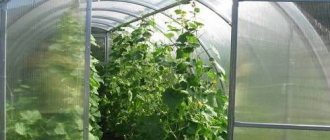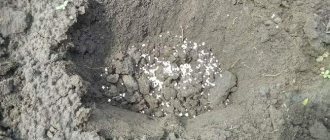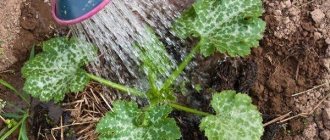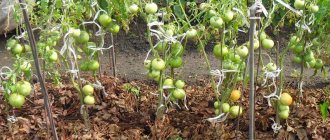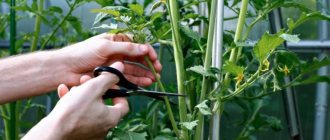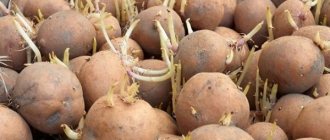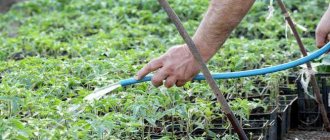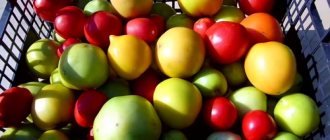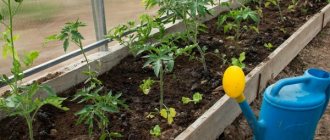Feeding schedule: when to fertilize seedlings
If fertile soil was used for planting tomato seedlings, then at first the seedlings will take food from there. Next, they focus on the condition of the seedlings.
Young plants do not yet have developed roots and green mass, so a lack of nutrients will lead to delayed development and weakening of the bush.
Important! Low room temperature, poor soil composition, short daylight hours and other disturbances in growing conditions - these and other factors affect the condition of the plants and can cause the death of seedlings.
Basic rules for fertilizing:
- Compliance with the measure and dosage. Seedlings are as sensitive to excess nutrition as to deficiency.
- Liquid formulations are preferred . Dissolved substances quickly penetrate into the root environment.
- The soil in cups is watered a day before fertilizing.
- The surface of the soil is loosened to allow air to penetrate deeper.
| Feeding number | When they contribute | Fertilizer |
| 1 | On the third day after the cotyledon leaves bloom | 2 g calcium nitrate per 1 liter of water |
| 2 | In 7-10 days | Organo-mineral complex, half the recommended dose according to the instructions |
| 3 | 2 true leaves | For 1 liter of water 7 g of superphosphate |
| 4 | 4 true leaves (after a week) | 2 g calcium nitrate per 1 liter of water |
| 5 | 7-8 true sheets | For 1 liter of water 1 g of urea, 1 g of potassium nitrate, 0.5 g of magnesium sulfate |
| 6 | 10-12 sheets | For 1 liter of water 1 g of potassium, 2 g of nitrate, 3 ml of humate |
Is it enough to just fertilize?
In order to get full-fledged viable tomato seedlings, which will subsequently delight you with rich harvests and be strong, you should pay attention to several more important factors. These include:
- High quality tomato seeds. Quality can be guaranteed by our own seed fund (not from hybrid varieties) or zoned varieties from proven specialized outlets;
- Sufficient space. To obtain strong tomato seedlings, they should not sit too thickly: after picking - at least 2 cm (on average - 5-6, if transplants are not planned in the nursery), and when planting in the ground - at least 40 cm. The ideal option is picking in pots;
- Sufficient lighting. One of the main conditions for successfully growing tomato seedlings, especially at home. If the daylight hours are less than 12 hours, then it can be lengthened with artificial lighting: fluorescent lamps, LED lamps, ordinary incandescent lamps. In mid-latitudes, it is enough to slightly postpone the cultivation time to a later period - with sufficient nutrition and sunlight, the seedlings grow very quickly;
- Fertile soil. The optimal combination: equal parts of humus, peat and sand mixed with a double portion of garden soil. To increase nutritional properties, you can add 100 g of complex fertilizer and wood ash to a bucket of soil;
- Timely watering. Tomato seedlings love rare, abundant watering - after the soil has completely dried.
Important! In addition to watering, fertilizing and other factors, loosening is important. Even if weeding is not required, but the top layer is caked and crusted, you should carefully loosen the rows so as not to touch the roots. This will improve gas exchange in the soil and allow oxygen to reach the roots.
Rules for applying fertilizers
The frequency of fertilizing depends on the development phase of the tomatoes.
First feeding
Sprouting requires little auxiliary nutrition. 2 days after the cotyledon leaves have unfolded, the sprouts are watered with 1 liter of water with 2 g of calcium nitrate.
A week after emergence, the seedlings are watered with a solution of “Potassium Humate”. If the soil has not been fertilized, then feed it once per 10 liters of water:
- 15 g of potassium sulfate;
- 40 g double superphosphate;
- 5 g of saltpeter.
Can be replaced with complex fertilizer.
After the pick
2 weeks after picking, the seedlings are fed. By this time, it has taken root and is ready to actively absorb nutrition. Organo-mineral compositions give excellent results . After 10 days, the procedure is repeated again.
In the process of growing
In the phase of 5-6 leaves, water with a solution of calcium and potassium nitrate (1.5 g per 1 liter of water). This will prevent the seedlings from growing rapidly upward. With the beginning of budding, they are fed with a preparation based on humate and nitrogen.
Before transplanting into the ground
A week before planting on the garden bed, prepare a solution of 10 liters of water, 1 tbsp. l. superphosphate, 2 tbsp. l. potassium nitrate. 200 ml is poured under 1 plant. Organic matter is introduced into the planting hole, where it will gradually disperse into the ground.
How can you feed
Feed the seedlings either in the morning or in the evening. The main thing is that the sun's rays do not burn, otherwise the whole process will go down the drain.
Root feeding
This feeding method involves supplying nutrients directly to the root system. Both organic and mineral fertilizers, both dry and liquid, are used here.
However, according to experienced gardeners, liquid fertilizers are better absorbed.
For treating seedlings, ready-made preparations prepared for specific crops are recommended. Fertilizer is introduced under the root; for this, use a watering can with a narrow long nose or a medical syringe without a needle. This way you can carefully feed the plant without disturbing the leaves.
Foliar feeding
If in the first case it is necessary for the solution to get into the soil, then foliar feeding is a method of pollination. The liquid composition envelops the bushes in microscopic drops, which are easily absorbed into the leaves and trunk of the sprouts. This method increases plant immunity.
Fertilizer should be sprayed so that all parts of the plant receive a “shower”. The first foliar feeding is carried out after the appearance of true leaves. The second is during the flowering period.
For foliar feeding, Energen, Zircon, Ecopin and other stimulants are used.
It is worth noting that this type of seedling treatment is effective:
- In tomatoes - if the trunks are too elongated.
- In cucumbers - as a prevention of peronosporosis.
- Cabbage acts as protection against pests.
- In flowers - if the sprouts are too stretchy.
The main thing that a gardener should remember:
The fertilizer should be diluted according to the instructions; doing it on your own can lead to disease and death of the plants.
Ready-made formulations and folk remedies
Agricultural preparations contain a balanced amount of vital substances. Their use according to instructions almost never causes side effects. Proven folk recipes for growing tomatoes serve as a good alternative to chemicals.
Mineral fertilizers
Throughout the growing season, tomatoes need nitrogen, phosphorus and potassium as the main chemical elements. Mineral complexes consist of different combinations of these substances and are supplemented with other important trace elements. This is explained by the fact that each fertilizer is aimed at replenishing the lack of a certain substance or several.
Superphosphate
Superphosphate has a multifaceted positive effect when growing tomato seedlings:
- stimulates the development of root appendages;
- strengthens plant tissues;
- participates in photosynthesis and the formation of brushes;
- slows down aging.
They produce simple and double superphosphate, their difference is in the ratio of the main element, nitrogen and sulfur.
The first time superphosphate is given to seedlings 15 days after picking. Next feeding after 2 weeks. Add 15 g of the drug to 10 liters of hot water, stir thoroughly and wait for it to cool. Water at the root.
Urea
Urea is an inexpensive and effective fertilizer , half consisting of nitrogen, which allows you to grow strong and hardy seedlings.
It is advisable to feed tomatoes with urea leaf by leaf . Dissolve 7-10 g in a bucket of water and spray seedlings with 3-4 true leaves.
For watering at the root, 40 g of urea is diluted in the same amount of water. Use a solution at room temperature; cold fertilizing stresses the seedlings. Exceeding the dose will cause burns to the roots or leaves.
Potassium monophosphate
Potassium monophosphate is produced in the form of crystalline powder, the ratio of phosphorus and potassium is 52% and 34%. Advantages:
- dissolves without residue;
- acidifies the soil;
- stops the stretching of seedlings;
- easily accessible formula;
- accelerates the formation of flower brushes;
- combines with many pesticides;
- softens hard water.
It should not be used simultaneously with calcium and magnesium, as they interfere with each other.
Dissolve 10 g of monophosphate in 10 liters of water and water the tomatoes in the phase of 2-3 leaves. Feeding will stimulate root growth. After 15 days, repeat, can be combined with nitrogen supplementation.
Ready-made drugs
“Krepysh” is a high-quality fertilizer of mineral-organic composition. Suitable not only for feeding tomatoes, but also flowers, vegetables, and ornamental crops. Available in liquid form and granules. Shelf life: 3 years.
Folk tips for tomato seedlings
In addition to industrial preparations to stimulate the growth of tomatoes, many gardeners water their seedlings with products prepared at home. Experienced gardeners and gardeners try to use only natural compounds, believing that they will be better and safer for watering tomatoes than store-bought preparations.
Maybe you will be interested in reading and useful to know what to do if tomato seedlings are stretched out and thin, so that they become strong and thick, in the article https://mir-ogorodik.ru/rassada-pomidor-vytyyanulas-chto-delat-ochen-tonkaya -after-vshodov/
Having studied their recommendations, it is worth highlighting some practical tips for processing nightshade crops to stimulate their growth.
- Watering the seedlings with an infusion of onion peels, thanks to which the stems come to life and become stronger. In addition, onion peels help destroy pathogenic microflora.
- By treating plants with a 3.5% baking soda solution, you can get a tomato crop with sweeter and fleshier fruits.
- Nettle infusion is used to enrich the soil with microelements and nitrogen.
- If a white coating appears on the soil, you can treat the soil with an infusion of garlic pulp. To do this, grated garlic is diluted with water in proportions of 1 to 50.
Often, a solution prepared on the basis of iodine is used for irrigation. Its proportions must be strictly observed so that the plants do not burn. Thanks to this watering, the bushes begin to grow faster, the stems become strong and thick, and the leaves look juicy, bright green, and productivity increases.
Latest articles for gardeners, gardeners and flower growers
Ammonia in the garden application for strawberries
Feeding tomato and pepper seedlings with folk remedies
Lunar sowing calendar for 2022 gardener table
Pruning raspberries in spring: how to do it correctly
To prepare an iodine solution, you need to drop 1 drop of iodine into a 3-liter jar of settled water. During the period of plant growth, they need to be watered with this solution once.
To get rid of late blight, use the following recipe with iodine:
· you need to take a large container and pour 10 liters of water into it;
Add a liter of milk to the container;
· drop 15 drops of iodine.
The bushes are sprayed with this solution every two weeks. The bush should be moistened generously to reduce the risk of late blight.
One of the most popular ways to stimulate seedling growth is treatment with live yeast. You need to take:
· 5 grams of dry yeast;
· 5 teaspoons of sugar;
· a glass of wood ash;
· 0.5 tbsp. water.
After mixing all the ingredients, you need to wait until the yeast begins to act. The appearance of a yeast cap indicates the mass is ready to prepare an infusion. The resulting mass is diluted with water in a ratio of 1 to 10.
After watering the seedlings, the plants become strong, their growth increases, and their resistance to pathogenic bacteria and fungi increases. This solution is used as an immunostimulant and growth activator. When treating seedlings with this solution, you can obtain a completely organic, environmentally friendly product.
Common problems when growing seedlings
The appearance and shape of the bush suggests that there are problems with nutrition or maintenance. If the temperature, humidity and light are normal, but the color of the leaves changes, the seedlings grow poorly or have stopped growing altogether, then the plant is experiencing a lack of nutrition.
Thin stem
Pulling of seedlings can be stopped at any stage. This often happens due to excess nitrogen in the soil. Potassium fertilizer is added to the plants; it will stimulate root growth and temporarily inhibit upward growth.
When to feed
In the first months of life, plants especially need careful care. Feeding is one of the essential conditions for good growth. Healthy seedlings have a strong trunk and leaves, and they themselves have a pleasant, cheerful green color.
Experienced gardeners read plants like a book, that is, by their appearance they can determine what the crop lacks for good development:
- Lightened lower leaves indicate a lack of nitrogen.
- Potassium deficiency results in the appearance of yellowness on the leaves, and the tips of the leaves begin to dry out.
- Lack of phosphorus - purple, bluish tints of leaves, weakness of shoots.
- The lethargy of sprouts is due to a lack or, on the contrary, an excess of sun.
If there is at least one of the signs, you need to take immediate action.
It is important to know,
that each crop requires special fertilizers, as well as special care rules.
Timing of fertilizing on the windowsill
Feeding should be done once a week, not more often. Moreover, when the plants have undergone picking, that is, they have at least two or three true leaves. Experts advise feeding small sprouts in the morning or evening, during hours when there is no sun. Moreover, the solutions are poured under the root; it is not advisable to get them on the leaves. Before fertilizing, first carry out regular watering so that the soil becomes moist.
It is recommended to alternate organic fertilizers with mineral ones if the plant is withering, but do not overwater it, otherwise it will die. If you do not have confidence in your own abilities and the ability to prepare a solution for feeding yourself, it is better to use ready-made formulations that can be bought in a specialized store.
When seedlings do not need fertilizers
To restore the roots, seedlings after picking or transshipment are not disturbed for 12-15 days. At this time, the plants are not yet receptive to nutrition.
You should not give fertilizers too often, even if there was a clear lack of any element. Exceeding the dose is fraught with stunted growth and weakening of protective functions.
Basic and additional batteries
The main purpose of applying mineral fertilizers and organic matter is to provide timely nutrition. At different stages of tomato development, the need for certain components changes. Seedlings are fed in relatively small doses so that the substances are absorbed evenly. You cannot do without fertilizer if the seedlings have been in the same soil for a long time and its resources are running out.
Important! The composition of ready-made complexes is known and their use simplifies the task. The percentage of the ratio of substances in organic matter is not known, so it is used carefully, without increasing the dose.
The division of nutrients into macro- and microelements is carried out according to the principle of their content in plant tissues.
Nitrogen is the main material for protein synthesis. At first the need for it is low, it increases when the fruits are filled on the first cluster. Deficiency or excess sharply reduces overall yield . Nitrogen is needed for the growth of greenery, roots, and reproductive organs. Plants absorb it in nitrate or ammonium form.
Phosphorus is extremely important at the initial stage of seedling growth. It promotes:
- growth of the root system;
- earlier flowering and fruiting;
- increases sugar content.
After picking, be sure to water the pots with fertilizer with a high phosphorus content.
The role of potassium for tomatoes is varied:
- maintaining water balance;
- formation of sugars;
- strengthening the immune system;
- enhancing the absorption of manganese.
The need for potassium increases during flowering and budding .
Calcium is not mixed with other mineral preparations; it is not compatible with phosphorus and sulfur. The element is responsible for the overall development of seedlings, neutralizes toxins, and is responsible for the absorption of other elements. Affects carbohydrate and protein metabolism. The need for calcium in tomatoes can be traced at the very beginning of growth. It helps accumulate nutrients and break them down into simpler compounds.
Without microelements, tomatoes die, develop poorly, and have low disease resistance. The correct balance of minerals is expressed in:
- continuous growth of seedlings;
- rich green color and brightness of the leaves;
- timely flowering and ovary formation.
Important! Microelements serve as vitamins for the plant. They are part of cellular structures, the immune system, and participate in all internal processes.
Identifying element shortages
If the seedlings have a stunted appearance, the color has faded, then this is a signal of a lack of one or more essential substances.
Signs of element deficiency
Signs of phosphorus deficiency :
- growth inhibition;
- thin and short stems;
- small leaves located upward at an acute angle;
- on the old ones there is a crimson underside, the veins are violet-red;
- roots rise from the soil and are visible on the surface.
Phosphorus starvation often occurs when watering with hard water.
Nitrogen deficiency causes:
- shredding of leaves, yellowing, falling off in the acute phase;
- the reverse side becomes purple;
- the stems become tanned, the brushes do not develop;
- there is a high probability of gray rot and late blight.
Due to potassium deficiency, the foliage becomes uneven and lumpy, the edges turn yellow and then dry out. This occurs from tissue dehydration and slower movement of substances. The stems become thin and woody, and few buds form in the clusters.
Lack of calcium weakens the development of roots, the tops of stems, leaves become chlorotic, curl, and become corrugated. The first and subsequent ovaries are affected by blossom end rot. Often the phenomenon is caused by excess nitrogen, magnesium, and potassium.
Excess nitrogen
With a relative excess of nitrogen, tomatoes develop very powerful foliage and no ovaries in the clusters. Then immunity decreases, leaves curl, and dying dark yellow spots appear. If excess nitrogen is detected, potassium is added and foliar feeding of tomatoes with microelements is done.
Advice from experienced gardeners
The most important first step is to choose the right tomato varieties to sow your seeds for seedlings.
Always adhere to the fertilizer application schedule. The condition of the seedlings is carefully monitored, and developmental deviations are recorded.
Sometimes seedlings turn yellow and stretch out not from poor nutrition, but from a lack of light. In this case, additional lighting will be organized.
For normal absorption of nutrients by the plant, a stable temperature (+22+25°C) is required. If the soil is cold, the absorption process will be difficult. This is especially dangerous for the absorption of phosphorus.
Liquid feeding during the day leads to leaf burns. It is permissible to carry out work in the morning and before sunset.
Why do seedlings stretch out?
Growing high-quality seedlings is painstaking and complex work that takes a lot of time. If you do not follow all the recommendations and rules, you may end up with low-quality material for planting in open ground. With a lack of light, a certain temperature regime, watering and nutrients, the plant becomes sluggish, elongated, thin and brittle. When such crops are transplanted into open ground, they wilt and subsequently die, or the yield is below normal.
Pulling is a popular problem among gardeners. This process is characterized by a large distance between nodes on the trunk.
Most often it occurs as a result of such provoking factors:
- incorrectly selected temperature conditions;
- lack of sunlight and artificial lighting.
These two factors coincide when growing seedlings at home. It is recommended to sow seeds at temperatures above +20 degrees. When the first shoots appear, the degrees drop to +17. It is problematic to create these conditions at home, but in greenhouse conditions (with heating) it is quite possible.
As for lighting, the house does not always have windows facing the sunny side. Also in early spring, when seedlings are grown, cloudy weather is observed. With a lack of light, the plant not only stretches out, it becomes thin, turns yellow and withers. At first, young shoots require at least 16 hours of lighting, which cannot be achieved only naturally. Therefore, it is recommended to use special artificial lighting. The best option in this situation is fluorescent indoor lamps or LEDs.
Thickened planting, which is observed when sowing seeds in one container, can also provoke stretching. After germination, the plants are located too close to each other, and each one tries to get a place in the sun. This can also provoke an uneven distribution of nutrients and the development of fungal, viral and bacterial diseases. Therefore, thinning or picking is carried out, after which intensive growth and development is observed.
The quality of seedlings is also influenced by soil composition. To do this, you can purchase a special soil mixture or prepare it yourself. It must be treated to prevent the spread and development of diseases and pests.
Fertilizers containing a large amount of nitrogen but little potassium and phosphorus are not suitable for tomatoes. Therefore, before using them (especially complex products), you need to pay attention to the percentage composition.
If the seedlings are oversaturated with nutrients, problems also arise.
Signs that will help determine oversaturation:
- curling of the upper foliage;
- the top of the crop looks dented.
In this situation, infection by pests and diseases should be excluded. If the reason is definitely an oversaturation of fertilizers, then fertilizing is suspended.
Stretching of seedlings also occurs with frequent excessive watering. It is recommended to carry out it as needed, preferably in the morning. It is necessary to avoid stagnation of liquid in the container. Watering should be uniform and between rows, this eliminates the possibility of damage to the seedlings. Use settled or filtered water at room temperature. Before planting in the ground, watering is reduced, the seedlings are hardened, that is, the process of plant adaptation is carried out.
Why don't tomatoes grow?
The process of active growth in tomatoes begins after they are planted in open ground. However, there are two options for the development of events: the seedlings have taken root well in the new place and are developing quickly, or they are growing poorly and then stop developing altogether. Reasons for slow growth may be :
- clogged, compressed, airtight soil;
- unsuitable soil composition;
- adverse weather conditions;
- lack of nutrients in the soil;
- improper care.
